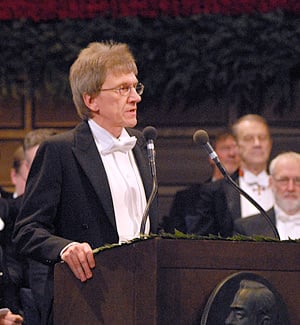Award ceremony speech

Professor Bertil Holmlund delivering the Presentation Speech for the Sveriges Riksbank Prize in Economic Sciences in Memory of Alfred Nobel 2008 at the Stockholm Concert Hall.
Copyright © The Nobel Foundation 2008
Photo: Hans Mehlin
English
Swedish
Presentation Speech by Professor Bertil Holmlund, Member of the Royal Swedish Academy of Sciences, Chairman of the Economics Prize Committee, 10 December 2008
Your Majesties, Your Royal Highnesses, Honoured Laureates, Ladies and Gentlemen,
To an ever greater extent, international trade intertwines the world’s economies with each other. Early in the 1950s, Swedish exports were equivalent to about 10 per cent of Gross Domestic Product; today exports amount to more than 50 per cent of GDP. A similar trend applies to a great majority of countries.
Questions about the causes and effects of international trade are among the classic fields of economic research. What determines trade patterns? Does trade enhance welfare? Who gains and who loses from trade? Nearly 200 years ago, the English economist David Ricardo developed his theory of comparative advantage, which explains trade in terms of differences in technology among various countries. A country that is relatively more efficient in producing a given good will export this good and import goods for which it has comparative disadvantages.
In the 1920s, the Swedish economists Eli Heckscher and Bertil Ohlin developed a new theory that explains trade in terms of differences in relative access to factors of production, for example labour and capital. A country tends to export goods whose production requires a relatively large quantity of a production factor that is very abundant in that country.
The common element between Ricardo’s theory and the Heckscher-Ohlin theory is that trade occurs when countries differ with respect to technologies or factor proportions. But in reality, world trade is dominated by flows between countries that have similar characteristics. A large proportion of trade also involves goods of the same type. The car industry is one of many examples: Sweden exports Volvo and Saab cars to Germany, while importing Mercedes and Volkswagen cars from Germany. Trying to explain such phenomena on the basis of differences in technology or factor endowments seems far-fetched.
In 1979, Paul Krugman presented a new theory of international trade that explains the occurrence of trade in similar products between countries with identical characteristics. One central assumption behind this theory is that many goods can be produced more cheaply in long series, in other words there are economies of scale. Another assumption is that consumers appreciate diversity in their consumption. Trade makes it possible to replace small-scale production for a local market with large-scale production for a world market in which companies with different brands compete with each other.
Krugman’s model was elegant, persuasive and highly influential. His new trade theory provided a whole new picture of the benefits of free trade. This theory has evolved quickly since Krugman’s pioneering contributions, today providing the basis for calculations of the effects of removing various trade barriers.
In his 1979 article, Krugman not only laid the groundwork for a new trade theory; he also sowed the seed for a new theory of economic geography – a theory that he developed 12 years later. This new theory helps us to understand rapid worldwide urbanisation. Today, for the first time in history, more than half of the earth’s population lives in cities.
As earlier, Krugman’s analytical assumption is that there are economies of scale in production at the same time as consumers demand a differentiated range of goods. But he also adds a new dimension: labour mobility between different regions. Highly populated regions are attractive because they offer a richer choice of different goods. Companies, too, have incentives to move to highly populated regions, since they can thereby keep down transport costs and meanwhile benefit from economies of scale. A self-reinforcing process may arise, with migration to cities making possible greater economies of scale and thereby further reinforcing the attractiveness of cities. Krugman shows that the end result may be a concentration of most economic activity in one or a few regions. The exact outcome depends on the interactions among transport costs, economies of scale and consumer demand.
Dear Professor Krugman:
You initiated the new trade theory and were able to show how economies of scale in production along with consumers’ preferences for variety could generate trade among countries that are identical in terms of technology and factor endowments. By doing so, you were able to explain the bulk of trade that takes place in modern economies. You also initiated the new economic geography which helps us understand rural decline and the growth of cities. In this way, you have unified two previously separate fields of economic research.
It is an honour and a privilege to convey to you, on behalf of the Royal Swedish Academy of Sciences, our warmest congratulations. I now ask you to receive your Prize from His Majesty the King.
Nobel Prizes and laureates
Six prizes were awarded for achievements that have conferred the greatest benefit to humankind. The 12 laureates' work and discoveries range from proteins' structures and machine learning to fighting for a world free of nuclear weapons.
See them all presented here.
